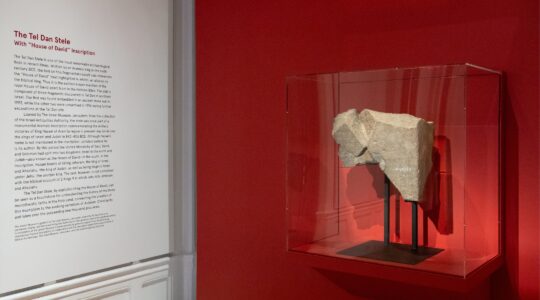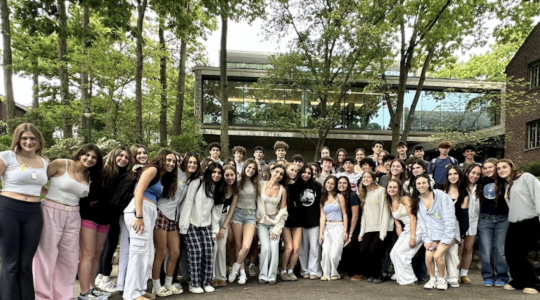If ever an architectural feature of a building’s exterior stood as a symbol for the life within, then the defaced plaque honoring the late Rabbi Menachem Mendel Schneerson at Lubavitch headquarters in Crown Heights is it.
Like the jagged fault line that eventually brings down the mansion in the famous Edgar Allan Poe story "Fall of the House of Usher," the cornerstone (which has been vandalized many times over the past few months and was violently ripped out this week) has come to represent a movement bitterly split by those who believe Rabbi Schneerson is the messiah and those who do not.
The plaque was put up seven years ago by the anti-messianists and bears the inscription "of blessed memory" after the rebbe’s name, referring to him in past tense.
Apparently that was too much to bear for some messianistswho began defacing it as soon as it was set in place.
The two camps (the anti-messianists run the Chabad worldwide outreach, while the messianists, a smaller but very active gorup, control the street in Crown Heights) have waged a simmering war since 1994, when the Lubavitcher rebbe died. But in recent weeks the battle has intensified over who controls the main synagogue at 770 Eastern Parkway, Lubavitch headquarters and home to the messianists.
Starting in November, fights have broken out at the site of the plaque, security guards have been hired to protect the cornerstone, arrests have been made and the feud has moved beyond Crown Heights and spilled into secular court.
All of this on the eve of the rebbe’s 11th yahrtzeit, July 10 this year, when thousands of Lubavitchers are expected to gather at the Queens grave of Rabbi Schneerson.
Some fear that things have deteriorated to the point that the image of Lubavitch (4,000 emissaries spreading Yiddishkeit throughout the world in a $1 billion-a-year-enterprise) could be irrevocably tarnished by the mess in Crown Heights.
"If people believe that many Lubavitch chasidim are crazy people, that will damage their image," said Rabbi David Berger, a history professor at Brooklyn College.
Rabbi Berger, author of the 2001 book "The Rebbe, The Messiah and the Scandal of Orthodox Indifference," is considered an arch-critic of the messianist camp, who believes the messianic impulse is beyond the bounds of normative Judaism.
"It could damage fundraising," he said. "You don’t want people to believe your movement consists primarily of lunatics. If people who declare this publicly are seen as those controlling the central headquarters of the entire movement, then people worldwide will come to think that most Lubavitch chasidim believe the rebbe is the messiah."
Despite Rabbi Berger’s fears, and those of anti-messianist officials in Crown Heights, the number of emissaries, or shluchim, seems to be growing, according to the movement.
Support the New York Jewish Week
Our nonprofit newsroom depends on readers like you. Make a donation now to support independent Jewish journalism in New York.
Nevertheless, the chairman of the emissaries’ network and other central Lubavitch organizations, Rabbi Yehuda Krinsky, has gone to state court in Brooklyn in an effort to stop the messianists.While the lawsuit is narrowly about the damage to the cornerstone and plaque, it is also appears to be about who controls what happens at 770: the Rabbi Krinsky-led faction or those who have been running the synagogue inside 770.
Within the buildings’ walls, ardent messianists are in charge, controlled by a small group of men known as the Gaboyim who are chosen in periodic elections. The most recent vote was in January.
That the dispute is centered at 770 "has tremendous symbolic significance," said Rabbi Berger.
"When they talk about the rebbe revealing himself, they talk about him walking into 770," he said. "One of the rebbe’s discourses from the 1980s said that when the redemption comes and the final Temple comes down from heaven, it will come down into Crown Heights right next to 770, and the adjoining buildings will be transported to Jerusalem."
In Crown Heights itself, the pro-moshiach [Hebrew for messiah] faction seems to be increasingly flexing its muscles.
Posters bearing the rebbe’s photo with the word Messiah have been put up stealthily outside Crown Heights, in downtown Brooklyn, even across from a mosque in the heavily Arab Atlantic Avenue neighborhood.
And in the quiet hours before dawn Tuesday, someone gouged out of the front exterior wall of 770 Eastern Parkway much of the cornerstone and the stone plaque surrounding it. This vandalism, along with other defacements through the years, is seen to be the work of young Israelis who believe the rebbe is the messiah, and not an organized effort.
The messianists believe the rebbe remains physically alive but concealed from view.
Tuesday’s vandalism occurred even though there has been a uniformed guard posted next to the plaque since Nov. 3, when in the early morning hours, several young Lubavitch men wrenched the defaced plaque off the wall and tried to put up their own, using the honorific "Shlita," an Aramaic abbreviation for "He should live for many long years," which conventionally follows the name of a living sage.
A spokesman for the organizations that own 770 and hired the guard said they are investigating.
The "of blessed memory" inscription was scratched out by the pro-messianists soon after the plaque was installed. The defaced plaque has remained in place.
Following the November incident the police were called, several arrests were made and Rabbi Krinsky, chairman of the Lubavitch organizations that own 770, went to court. A temporary restraining order was placed against the messianists, who are referred to by their opponents as "the Taliban."
Support the New York Jewish Week
Our nonprofit newsroom depends on readers like you. Make a donation now to support independent Jewish journalism in New York.
The messianists, in turn, refer to Rabbi Krinsky as "the megalomaniac," someone trying to pull the strings from an office high above the street to control the expression of the will of the people there.
Rabbi Ariel Sokolovsky was among the men arrested Nov. 3. The Boston resident is an ardent messianist who visits 770 several times a year.
"I describe the rebbe as alive," Rabbi Sokolovsky said in an interview. "The body of moshiach does not die, even if it appears to be so. A tzaddik [righteous person] can materialize himself in the world if he needs to.
"Concealment does not mean that the rebbe has an invisible body," he said. "It has to do with people’s readiness to see it. It’s people’s perception."
Rabbi Sokolovsky said he has met people who have seen the rebbe in person since he died.
That perspective offends some.
"For so-called Orthodox Jews to say this undermines a basic argument against Christianity that’s been going on for over 1,000 years," said Rabbi Berger. "It’s a betrayal of the Jewish belief in messianism, whose parameters have been defined to exclude the possibility that the messiah would declare the redemption is coming in his generation and die without completing the task."
It is this issue that has the anti-messianists worried.
A messianist image being projected louder from 770 could have widespread implications for the network of emissaries who provide everything from Jewish preschools to camps to congregational leadership in hundreds of Jewish communities around the globe: and in some places where they are the only Jewish presence.
The aggregate operating budget for the emissaries is roughly $1 billion a year, according to Lubavitch sources, not including capital projects.
A large banner proclaiming the rebbe as the messiah has long hung on the wall of the main sanctuary at 770. For the past few years, the curtain over the ark holding the Torah scrolls has been embroidered with the same sentiment.
Upstairs in the women’s section, a large tzedaka box built into a wall bears the large letters "Beit Moshiach," for "House of the Messiah," and pro-messianist literature is all over.
Support the New York Jewish Week
Our nonprofit newsroom depends on readers like you. Make a donation now to support independent Jewish journalism in New York.
During a recent visit to 770 several men downstairs, having just finished the afternoon prayers, were passionately singing the chant that has become the messianists’ slogan: "Long live our master, our teacher, our rabbi, King Messiah, forever and ever!"
One man clutched a fistful of small plastic yellow flags with the messianic crown on it. A few others danced around during the song. Many of the men in the sanctuary, however, did not participate.
"It’s very inspiring davening at 770 because everyone davens with special power because the rebbe is there," said Michael Rosenthal, a 24-year-old Lubavitcher who works for the emissary in Great Neck, in an interview outside.
Those who don’t subscribe to the aggressively pro-moshiach stance say they often avoid praying at 770.
"The more than 40 shtieblach [little neighborhood synagogues] around Crown Heights are full because people don’t want to subject their kids to the craziness," said one anti-messianist.
Jeffrey Buss, the attorney for the Gaboyim, invoked this week’s U.S. Supreme Court ambiguous rulings on the constitutionality of displaying the Ten Commandments on public property.
Buss has moved to have the lawsuit thrown out of court because he says it is about theological issues that are not within the purview of secular court.
The plaintiff’s attorney did not return phone calls. Rabbi Krinsky, through a spokesman, declined to comment.
The next court appearance is scheduled for July 6: four days before some Lubavitchers will light yahrtzeit candles in the rebbe’s memory, and others will not, instead proclaiming "Yechi! Long Live the King Messiah!"
The New York Jewish Week brings you the stories behind the headlines, keeping you connected to Jewish life in New York. Help sustain the reporting you trust by donating today.




